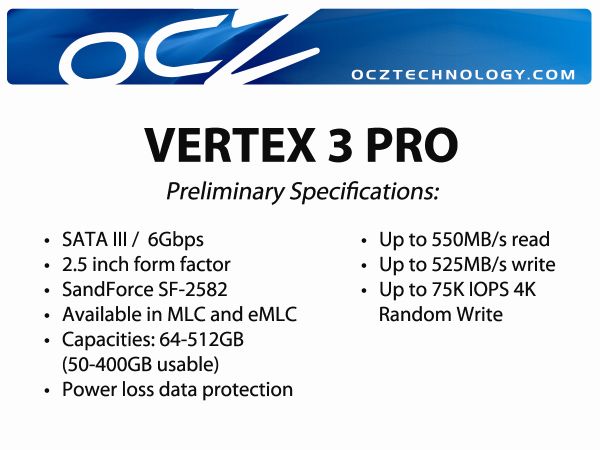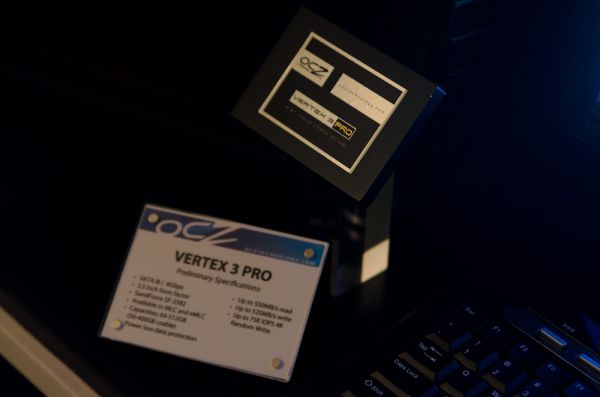OCZ'z Vertex 3 Pro Demo: World's First SandForce SF-2000
by Anand Lal Shimpi on January 5, 2011 9:37 PM ESTA few months ago SandForce announced its second generation SSD controller: the SF-2000 series. The specs SandForce released at the time were almost too good to be true. As a refresher here’s what we saw back in October of last year:

SandForce is promising a single enterprise level drive that can deliver 500MB/s sequential reads and writes (for highly compressible data), and up to 60K IOPS for 4KB random reads and writes. That’s not an evolutionary improvement, that’s more than a doubling of what most of the competition can do today. Even compared to existing SandForce drives it’s a huge increase in performance. But as I’ve heard many times before, anyone can put out a promising PDF.
Today at CES, OCZ previewed its first SF-2000 based drives: the Vertex 3 Pro and Vertex 3 EX. Both are based on SandForce’s SF-2582 controller, the highest end offering in the SF-2000 family. The drives won’t see the light of day for months (sometime in Q2) and what OCZ is showing today is very, *very* early silicon and hardware. The drives are using 32nm Toshiba toggle-mode NAND (effectively DDR NAND), however OCZ will go to market with 25nm Intel NAND when the drive is ready.
First let’s look at the specs OCZ is promising for these drives:
OCZ’s specs are even higher than SandForce’s. This is getting ridiculous. Thankfully, OCZ let me run some of my own Iometer tests on the drives to verify the claims. Surprisingly enough, the Vertex 3 Pro looks like it’s really as fast as OCZ and SandForce are claiming. When running highly compressible data (pseudo random in Iometer) at low queue depths, I get 518MB/s sequential write speed and nearly 500MB/s for sequential read speed. Remember this is the very first version of the drive and there’s months of tweaking ahead to get it ready for production. Performance may even increase by the time OCZ actually ships the drive. Furthermore, this is the performance of a single drive with a single controller - there’s no funny on-board RAID going on, we’re just talking about the performance of a single drive.
| OCZ Vertex 3 Pro Preliminary Test Data | ||||
| Iometer 2010 Test | Incompressible Data | Compressible Data | ||
| 128KB Sequential Write (QD=3) | 262.MB/s | 518.2MB/s | ||
| 128KB Sequential Read (QD=3) | 493.4MB/s | 492.3MB/s | ||
| 4KB Random Read (QD=3) | 186.5MB/s | N/A | ||
| 4KB Random Write (QD=3) | 162.7MB/s | 227.0MB/s | ||
Even if we look at incompressible data (fully random), the performance is unbelievable. You get better minimum performance on the SF-2582 than peak performance on the SF-1200/SF-1500. Note that we couldn't run all of our tests given the very early nature of the hardware sample. The fact that we could get these numbers at all on the first beta of the drive was beyond impressive.
Obviously to hit these speeds you need a 6Gbps controller. Thankfully there are at least a few ways to get those ports.
It’s looking like SandForce will be last to bring out their next-generation drive in the first half of the year with both Micron and Intel beating it to the punch, but if we can get this sort of performance, and have it be reliable, it may be worth the wait.


















62 Comments
View All Comments
jrocks84 - Wednesday, January 5, 2011 - link
Is the 25nm NAND from IMFT going to be DDR NAND?Chinoman - Wednesday, January 5, 2011 - link
Wouldn't anyone else like to see RAID 0 with TRIM support?CharonPDX - Thursday, January 6, 2011 - link
If the drive has good garbage collection in its own firmware, it doesn't need TRIM support.crimson117 - Thursday, January 6, 2011 - link
Garbage Collection is better than nothing, but never quite as good as TRIM.kb9fcc - Thursday, January 6, 2011 - link
Not needing either would be best.Taft12 - Thursday, January 6, 2011 - link
Citation?I'd be especially interested in seeing your statement backed up with regards to this hardware that isn't even released yet!
sprockkets - Thursday, January 6, 2011 - link
Garbage collection works better when it knows what garbage to collect, hence TRIM.GullLars - Saturday, January 8, 2011 - link
Garbage Collection and TRIM are not mutualy exclusive, and are both ways of maintaining write performance. If you don't have any GC at all working with write placement algorithms, you end up with something like early JMicron devices.TRIM simply allows the drive to not have false-valid data, meaning it can mark blocks as dirty and have them included in the GC instead of moved around.
This can significantly lower write amplification, and is more important the less unpartitioned space you have, as it allowes a second pool of dynamic freespace for GC to work with.
BTW, i'm running 4R0 C300 and get about 1150MB/s read on SB850 with ATTO, and about 100k random IOPS. I don't think Z-drive R3 can beat that, compressible data or not.
I also found 4x was overkill, 3x will get you past 1GB/s and 100k IOPS.
glugglug - Thursday, January 6, 2011 - link
Garbage collection and TRIM are totally unrelated. No matter how good your garbage collection is, it absolutely does not overlap with or remove the benefit of TRIM.bcronce - Thursday, January 13, 2011 - link
I wouldn't say "totally unrelated". TRIM augments the GC.TRIM does nothing more than flag blocks for the GC to clean up which reduces the amount of "guessing" the GC has to do.
Less guessing = better